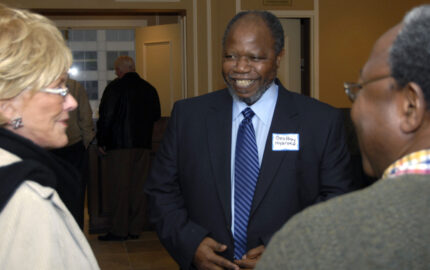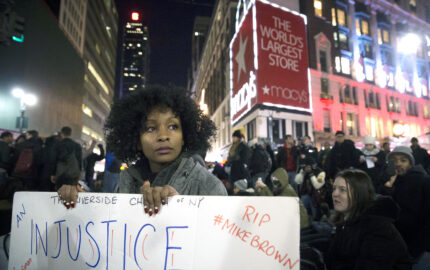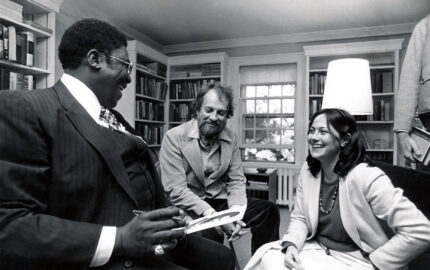As the crystal chandeliers began to dim on the elegant Grand Ballroom of the Waldorf Astoria Hotel in New York City—a room that usually hosts heads of state, foreign diplomats, and the occasional wedding—the emcee had a difficult time hushing the crowd.
It wasn’t because the nearly 400 journalists and media leaders dressed in semiformal evening attire were rude or inattentive. Rather it was that most of the distinguished crowd brought together this fall to honor the 25th anniversary of the nation’s most influential diversity journalism training center were just as happy hanging out with their friends and colleagues, having another drink, and swapping stories. This was, after all, a family reunion.
This “family,” and the thousands of journalists who have been touched by the Robert C. Maynard Institute for Journalism Education over the past quarter century, is made up of professionals of every color, gender and background. Many have had their careers shaped by the institute’s summer editing program or their lives changed by one of the institute’s mid-career management programs.
Family Members
From KNBC president and general manager Paula Madison to former Associated Press Managing Editors’ president Caesar Andrews, from current Nieman Fellow Ronnie Ramos—managing editor of The Fort Meyers News-Press—to San Jose Mercury News senior columnist Lisa Chung, the Maynard Institute has a long list of prestigious alumni, instructors and mentors. Distinguished journalists of color have emerged from Maynard programs and have gone on to run newsrooms around the country. Then they hire, promote and mentor others, passing the torch.
As a mid-career journalist, I had the chance to teach several years at the institute’s summer editing program during the early 90’s—at the time based at the University of Arizona in Tuscon. Despite the unforgiving heat of the desert (they kept saying it was only a “dry heat,” but I didn’t buy it) I found myself getting as much from the young copyeditors and assigning editors of all colors and backgrounds than I could ever give as a teacher. We’d spend long days reworking copy and going over page proofs and late nights sharing life stories at the local watering hole. The friendships formed during that time—Lewis Diuguid, now vice president of The Kansas City Star, was my roommate one year—have lasted a decade.
The pioneering Bob Maynard, his wife, Nancy Hicks Maynard, and seven other journalists founded the Maynard Institute in 1977. Bob was a world-class reporter and editor at The Washington Post and a Nieman Fellow, who later went on to be the first African-American owner of the Pulitzer Prize-winning Oakland Tribune, before he died in 1993. Many contend the Maynards, who had left prestigious jobs at The Washington Post and The New York Times to start the institute, were personally responsible for the creation or ascension of hundreds of African Americans and others in journalism during the past several decades.
Today, the Institute for Journalism Education is run by Bob’s daughter, Dori J. Maynard, who was named in October as the institute’s new president and CEO. Dori has been a reporter for The Bakersfield Californian, The Patriot Ledger in Quincy, Massachusetts, and at the Detroit Free Press, and when she became a Nieman Fellow in the fall of 1992, she and her dad became the first father/daughter fellows in the foundation’s history.
Maynard Programs
Nearly 2,000 journalists and media professionals have been through one of the institute’s many programs, which focus on management, editing, newsroom dynamics, and diversity:
The Maynard Institute is also busy expanding its reach by transforming its Web site (www.maynardije.org) into a destination resource for information about journalism and diversity and hosting the nationally recognized Web guru Richard Prince’s “Journal-isms” column (www.maynardije.org/columns/dickprince). And the staff is at work creating a way to provide newspapers around the country with an online interactive content audit. Editors will be able to use this to track ethnic, gender and age representation in the content of the newspapers and overlay relevant census information about the communities they serve.
But the lasting legacy of the Maynard Institute is in the thousands of journalists it has touched, the bonds that have been formed, and the multiplying effect it has had on journalism. And now that some of the original members of the “family” have grown up, started journalism families of their own in their newsrooms, the children and grandchildren of Bob Maynard’s vision certainly have the training and inspiration to guide journalism to the highest of standards for generations to come.
Bryan Monroe is a 2003 Nieman Fellow. He was previously deputy managing editor for news, visuals and technology at the San Jose Mercury News and will become assistant vice president/news for Knight Ridder when he completes his fellowship in June. He also taught for several years at the Maynard summer Editing Program.
It wasn’t because the nearly 400 journalists and media leaders dressed in semiformal evening attire were rude or inattentive. Rather it was that most of the distinguished crowd brought together this fall to honor the 25th anniversary of the nation’s most influential diversity journalism training center were just as happy hanging out with their friends and colleagues, having another drink, and swapping stories. This was, after all, a family reunion.
This “family,” and the thousands of journalists who have been touched by the Robert C. Maynard Institute for Journalism Education over the past quarter century, is made up of professionals of every color, gender and background. Many have had their careers shaped by the institute’s summer editing program or their lives changed by one of the institute’s mid-career management programs.
Family Members
From KNBC president and general manager Paula Madison to former Associated Press Managing Editors’ president Caesar Andrews, from current Nieman Fellow Ronnie Ramos—managing editor of The Fort Meyers News-Press—to San Jose Mercury News senior columnist Lisa Chung, the Maynard Institute has a long list of prestigious alumni, instructors and mentors. Distinguished journalists of color have emerged from Maynard programs and have gone on to run newsrooms around the country. Then they hire, promote and mentor others, passing the torch.
As a mid-career journalist, I had the chance to teach several years at the institute’s summer editing program during the early 90’s—at the time based at the University of Arizona in Tuscon. Despite the unforgiving heat of the desert (they kept saying it was only a “dry heat,” but I didn’t buy it) I found myself getting as much from the young copyeditors and assigning editors of all colors and backgrounds than I could ever give as a teacher. We’d spend long days reworking copy and going over page proofs and late nights sharing life stories at the local watering hole. The friendships formed during that time—Lewis Diuguid, now vice president of The Kansas City Star, was my roommate one year—have lasted a decade.
The pioneering Bob Maynard, his wife, Nancy Hicks Maynard, and seven other journalists founded the Maynard Institute in 1977. Bob was a world-class reporter and editor at The Washington Post and a Nieman Fellow, who later went on to be the first African-American owner of the Pulitzer Prize-winning Oakland Tribune, before he died in 1993. Many contend the Maynards, who had left prestigious jobs at The Washington Post and The New York Times to start the institute, were personally responsible for the creation or ascension of hundreds of African Americans and others in journalism during the past several decades.
Today, the Institute for Journalism Education is run by Bob’s daughter, Dori J. Maynard, who was named in October as the institute’s new president and CEO. Dori has been a reporter for The Bakersfield Californian, The Patriot Ledger in Quincy, Massachusetts, and at the Detroit Free Press, and when she became a Nieman Fellow in the fall of 1992, she and her dad became the first father/daughter fellows in the foundation’s history.
Maynard Programs
Nearly 2,000 journalists and media professionals have been through one of the institute’s many programs, which focus on management, editing, newsroom dynamics, and diversity:
- Management: The Maynard Institute holds an aggressive management training program at Northwestern University’s Kellogg Graduate School of Management in Evanston, Illinois. Business, strategy and cross-cultural techniques are used to shape new leaders from all areas of the media business.
- Editing: Its innovative summer editing workshop, usually held at UC Berkeley, lasts for six weeks and is an intensive boot camp designed for early-career copyeditors and new assigning editors. And next year it will be at the Freedom Forum Diversity Institute at Vanderbilt University in Tennessee.
- Cross-Media: During many of the major journalism conventions—such as the National Association of Hispanic Journalists’ annual workshop—staff from Maynard stage week-long Cross-Media Journalism seminars. They offer this program, which helps traditional journalists adapt in the converged world of new media, broadcast and print, at universities such as USC’s Annenberg School of Journalism.
- Fault Lines: And they have infiltrated dozens of American newsrooms and professional conferences with their “Fault Lines” training, taking Bob Maynard’s original premise that much of today’s racial and gender- based friction within the newsroom stems from a lack of understanding of each others’ points of tension and stress.
- History: With its History Project, the Maynard Institute has documented and archived the work of African-American journalists who covered the turbulent civil rights era of the 50’s, 60’s and 70’s. Their first component, “The Caldwell Journals,” was launched in 1999 and is a personal account of Earl Caldwell, the legendary New York Times reporter who fought in court the government’s attempts to seize his notes and reporting of the Black Panther Party. The case ultimately was argued in the U.S. Supreme Court and became the basis for many state “shield laws.” Caldwell was also the only reporter present when Martin Luther King, Jr. was assassinated in Memphis in 1968.
The Maynard Institute is also busy expanding its reach by transforming its Web site (www.maynardije.org) into a destination resource for information about journalism and diversity and hosting the nationally recognized Web guru Richard Prince’s “Journal-isms” column (www.maynardije.org/columns/dickprince). And the staff is at work creating a way to provide newspapers around the country with an online interactive content audit. Editors will be able to use this to track ethnic, gender and age representation in the content of the newspapers and overlay relevant census information about the communities they serve.
But the lasting legacy of the Maynard Institute is in the thousands of journalists it has touched, the bonds that have been formed, and the multiplying effect it has had on journalism. And now that some of the original members of the “family” have grown up, started journalism families of their own in their newsrooms, the children and grandchildren of Bob Maynard’s vision certainly have the training and inspiration to guide journalism to the highest of standards for generations to come.
Bryan Monroe is a 2003 Nieman Fellow. He was previously deputy managing editor for news, visuals and technology at the San Jose Mercury News and will become assistant vice president/news for Knight Ridder when he completes his fellowship in June. He also taught for several years at the Maynard summer Editing Program.



